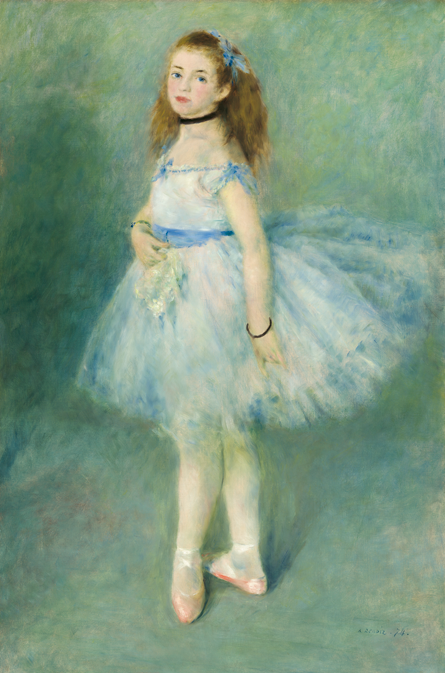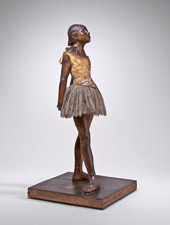Little Dancer is repeatedly called the most radical example of modern sculptural realism of its time, yet even then it eluded easy classification since observers of the period identified it with various forms of imagery — artistic, popular, and scientific.[1] Though it resembles little else, the figure has important, if nuanced, links with contemporary sculpture of the Salon, public spaces, and serial market.[2]

Fig. 1: Auguste Renoir, The Dancer, 1874, oil on canvas. National Gallery of Art, Washington, Widener Collection, 1942.9.72
As Kendall has noted, Degas’s statuette of an adolescent dancer offers an astringently new approach to the familiar subject of youth in nineteenth-century sculpture, which typically explores childhood naïveté (notably François Rude, Neapolitan Fisherboy, 1831 / 1833, marble, Musée du Louvre, Paris) or the mercurial child-adult qualities of adolescence.[3] Closer to Little Dancer are the many works that provide moral studies of teenage girls, as critics thought Little Dancer did, paying homage to France’s cherished teenage warrior Joan of Arc and to literary heroines such as the gypsy Esmeralda in Victor Hugo’s Hunchback of Notre Dame (Notre Dame de Paris, 1831).[4] Because sexuality plays a darkly powerful role in these stories,[5] such images provide an especially problematic dimension to the growing debate about human potential, from traditional divine will, immutable gender or racial features, and untainted natural virtue, to new theories of heredity and environment. The iconography of typical modern girls, especially urban types, is unusually open to such readings. Like British moralizing genre painting of modern bourgeois girls, French genre painting of their working-class counterparts includes commentaries on their penchant for waywardness — or works that were perceived as tracing their immoral course. An example that is especially close to Little Dancer involves three of Auguste Renoir’s entries in the 1874 impressionist exhibition, Dancer (fig. 1), the Parisienne (1874, oil on canvas, National Museum of Wales, Cardiff), and La Loge (1874, oil on canvas, Courtauld Gallery, London), paintings that one critic described at the time as possible images of the “three stages that the young women of Paris often go through,” from teenager to prostitute.[6]
Such comments about Renoir’s images of young women are similar to many published about Little Dancer in 1881, providing the basis for debates about the figure’s meaning today. Degas’s specification of a fourteen-year-old dancer carried especially wide-ranging portents for the future. On the brink of sexual maturity, fourteen was the age at which a French girl of those years traditionally received her First Communion, emulating the Virgin Mary at the Annunciation and Incarnation.[7] Age fourteen also signaled the student dancer’s transition to professionalism from her childhood as a rat, begun when she was admitted to the Opéra as a student around the age of eight. At fourteen she was either competing for, or possibly already performing in, the second quadrille, the lowest level of the ballerina’s professional ladder to grand sujet or even étoile.[8]
For Shackelford, Little Dancer was perhaps Degas’s most ambitious tribute to the ballet student’s dedication and struggle in pursuing an exacting craft, qualities that the artist admired in life and widely recorded in his two-dimensional work.[9] For later writers, the figure opened a Pandora’s Box of attitudes surrounding the rat. Often of modest birth, the student or emerging dancer embodied the many vices and criminal tendencies long attached to the lowest classes and theater world; her often lackluster talent relegated her to walk-on or minor dance roles that paid so poorly that she embarked on age-old alternatives, notably paid sex, turning to wealthy male subscribers of the Opéra who pursued younger dancers, often through the girls’ mothers. Rather than the charming gamine or even a sexual victim, the rat was seen by many contemporaries as a calculating sexual predator.

Fig. 2: Degas, Four Studies of a Dancer, c. 1878–1881, chalk and charcoal, heightened with gray wash and white, on buff wove paper. Musée du Louvre, Paris. Photo © RMN-Grand Palais / Art Resource, NY. Photographer: Jean-Gilles Berizzi
Such views of the young dancer grew out of the social realities of the glory days of the ballet at the Opéra on the rue Le Peletier in the 1820s and 1830s, a stereotype, established by extreme cases, that persisted even as the practice began to wane during the Second Empire.[10] There were nonetheless ongoing cases of sad or sordid reality in the 1870s and 1880s, such as Marie Van Goethem, one of Degas’s teenage dancer-models. Most consider her to be the model for Little Dancer, thanks primarily to the MARIE inscribed on one drawing presumably of her (see fig. 2).[11]
Marie was born to a Belgian working-class couple in Paris on June 7, 1865, the second of three surviving daughters who pursued Opéra careers.[12] The family moved frequently, mostly in the seedier areas of Degas’s neighborhood. By 1873, his notebook lists the oldest, twelve-year-old blond Antoinette, who never progressed beyond an unsalaried figurante (walk-on) in Opéra performances. Thirteen-year-old Marie and her younger sister Louise Joséphine (called Charlotte) were admitted to the Opéra dance academy as students in 1878.[13] Their father, a tailor, reportedly died by 1880, when Mme Van Goethem, by then occasionally hired as an extra habilleuse (dancer’s dresser), appears as a widow in Marie’s first contract for the corps de ballet.[14] Marie had only a brief and mediocre career, dancing in La Korrigane in 1880 and in Namouna in 1882. The family’s increasingly modest quarters suggest a downward spiral, and, according to gossipmongers, Mme Van Goethem began to hire out the girls for sex. Accused of stealing money from a wealthy escort in 1882, Antoinette was caught fleeing to Belgium with her mother and was imprisoned for three months, the last known details of her life. Also in 1882, the Opéra registers record Marie’s removal for nonattendance at the same time the press reports her at the cafés — similarly the last documented sign of her thus far, at age seventeen.
Notes
1. Theodore Reff, Degas: The Artist’s Mind (New York, 1976), 246; Alison Yarrington, “Under the Spell of Madame Tussaud: Aspects of ‘High’ and ‘Low’ in Nineteenth-Century Polychromed Sculpture,” in Andreas Blühm et al., The Colour of Sclpture, 1840–1910, exh. cat. (Amsterdam, 1996), 84 – 92; Richard Kendall, Degas and the Little Dancer, exh. cat. (New Haven and London, 1998), 45 – 64; Douglas Druick, “Framing The Little Dancer Aged Fourteen,” in Kendall, Degas and the Little Dancer, 86 – 88.
2. For Kendall (ibid., 25 – 26), building on Charles W. Millard (The Sculpture of Edgar Degas [Princeton, 1976], 47), Little Dancer is a paradigm or résumé of nineteenth-century French sculpture.
3. Kendall, Degas and the Little Dancer, 28 – 30. Another example is Hippolyte Moulin’s rambunctious Discovery at Pompeii (1863, bronze, Musée d’Orsay, Paris). See Anne Pingeot et al., Musée d’Orsay: Catalogue sommaire illustré des sculptures (Paris, 1986), 202, repro.
4. For monuments to Joan of Arc, see June Hargrove, The Statues of Paris: An Open-Air Pantheon (New York, 1989), 106 – 107, repro. For other adolescent heroines from literature and opera, see Harold Berman, Bronzes: Sculptors and Founders, 1800–1930, 2 vols. (Chicago, 1974 – 1976), 1: cats. 701 – 705; 2: cats. 1317 – 1318, all repro. The type may grow out of an old topos, the childhood of cultural heroes, that informed the vast nineteenth-century imagery of artists. See Ernst Kris and Otoo Kurz, “The Artist as Magician,” in Legend Muth and Magic in the Image of the Artist: A Historical Experiment, trans. Alastair Laing, rev. Lottie M. Newman (New Haven, 1979), 13 – 60.
5. Joan of Arc was executed in part because she continued to wear men’s clothing even when her life depended on returning to conventional women’s apparel. Esmeralda’s fate is determined by powerful males’ sexual attraction to her.
6. See Anne Distel’s discussion of these comments on Renoir’s painting by Jean Prouvaire in “L’Exposition du boulevard des Capucines,” Le Rappel, April 20, 1874, 3, in Anne Distel, “Cat. 28,” in Renoir, exh. cat. (London, 1985).
7. June Hargrove, “Little Fourteen-Year-Old Dancer: Madonna of the Third Republic?” in Horizons: Essays on Art and Art Research, ed. Hans-Jörg Heusser (Zurich, 2001), 152.
8. Kendall, Degas and the Little Dancer, 17 – 19; Jill DeVonyar and Richard Kendall, Degas and the Dance, exh. cat. (New York, 2002), 119 – 155. For period accounts of the nineteenth-century Opéra dancer’s training and advancement, see Paul Mahalin, Ces demoiselles de l’Opéra, (Paris, 1887); Berthe Bernay, La Danse au théâtre, (Paris, 1890); Cléo de Mérode, Le Ballet de ma vie, (Paris, 1955), 54 – 73. For discussions of the rat, see Mahalin, Ces demoiselles, 5 – 6; Martine Kahane, Le Foyer de la danse, exh. cat. (Paris, 1988), 11 – 12. George T. M. Shackelford, Degas: The Dancers (Washington, DC, 1984), 67, is one of the first modern scholars to address the importance of the given age in the dancer’s life.
9. Ibid.
10. Kahane, Le Foyer de la danse.
11. Pierre Michaut, “Immortalized in Sculpture: The Story of Louise Van Gothem,” Dance Magazine 38, no. 8 (August 1954), identifies the model instead as her younger sister Louise Joséphine [Charlotte] but does not reveal his evidence for that claim; the information could have come from Charlotte or her acquaintances. Age ten when the wax was first slated for display in 1880, Charlotte seems too young for the fourteen-year-old that Degas specified in the title. One of the earliest to identify Marie as the model for Little Dancer is Michèle Beaulieu, “Les Sculptures de Degas: Essai de chronologie,” Revue du Louvre et des Musées de France 19, no. 6 (1969): 375. Adding evidence for the identification, Reff, Degas: The Artist’s Mind, 244 – 245, and Millard, The Sculpture of Edgar Degas, 8 n. 26, point to her name and address on the drawing (see fig. 14) as well in a notebook dating from these years.
12. Kahane, in Martine Kahane et al., “Enquête sur la Petite Danseuse de quatorze ans de Degas,” 48/14: La Revue du Musée d’Orsay, no. 7 (Autumn 1998): 51. Unless otherwise noted, all subsequent details on the Van Goethems derive from this section of the article. Millard’s (Le Foyer de la danse, 8 n. 26) birth date of February 17, 1864, according to Kahane, is for an earlier Marie who died days after birth. The earliest known period chronicle mentioning Marie and her sisters is Louis Besson Panserose, “Paris la nuit: Le Ballet de l’Opéra,” L’Évenement, February 10, 1882, elaborated in Mahalin, Ces demoiselles, and steadily quoted beginning with Lillian Browse, Degas Dancers (Boston, 1949). No photographs or reliable images of Marie have come to light.
13. According to DeVonyar and Kendall, Degas and the Dance, 147, Marie’s unusually late age upon admission to the Opéra suggests she studied dance earlier somewhere else.
14. Additional records concerning probably Marie and Charlotte, cited as Vongothen (or Van Goethen) 1 and 2, document their examination results and promotions from January 1879 to December 1880; see Bibliothèque-musée de l’Opéra, Paris, Opéra Archives, 19/681 – 683.


